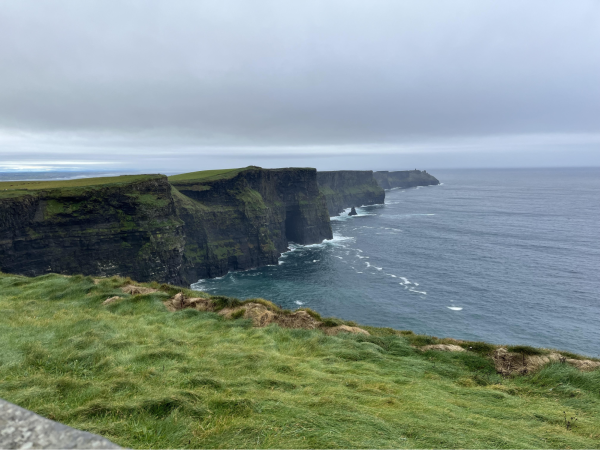Mike Caplan: The life of a television meteorologist
Photo By Mike Caplan
Meteorologist Mike Caplan stands on the set of Fox 32’s morning show Good Day Chicago. Caplan has worked for WFLD-TV FOX 32 Chicago since 2015.
Meteorologists are known for their work on television, and some that have been on TV are more well-known than others. From the legendary Tom Skilling to a day one meteorologist at some extremely isolated news station, meteorologists on TV come with different skill levels no matter where in the country they are located. Mike Caplan is one of those meteorologists who has extreme knowledge in the field of meteorology.
Based out of WFLD-TV FOX 32 Chicago since December 2015, Caplan has been interested in the weather since he was a little kid.
“I was very strong in science, speech and trombone. I knew I wasn’t going to make a living as a trombonist so I found a way to marry my science and ‘performance’ ability through mass communications studies in college,” Caplan recalled.
A Gurnee, Illinois, native, Caplan has been used to the nearly unpredictable Chicagoland weather patterns, which is what ultimately made him return to Chicago in the middle of 1994 as a TV meteorologist.
After graduating from high school at Warren Township in Gurnee, Caplan earned an associate degree from Lake County College in Grayslake, and then earned a bachelor’s degree from Illinois State University in Normal.
His first stint as a TV weatherman was at CBS affiliate WCIA in Champaign, Illinois.
“I started as an intern and was hired as a reporter during my internship. I became one of the weather anchors and the main host of a TV show called PM Magazine,” Caplan said.
As the host of PM Magazine, Caplan was able to interview famous people throughout the United States, including President Ronald Reagan. Caplan was one of the first reporters during Reagan’s presidency to be offered to interview the president one-on-one.
“Getting the chance to interview President Reagan was truly a once-in-a-lifetime experience, as not many people get the chance to do something as remarkable as what I did,” Caplan recounted.
After Mike quit his job at WCIA, he was hired by ABC affiliate WTVD in Raleigh, North Carolina, in 1987. Caplan worked at this station for six and a half years, he called it a “Great job!” and this was because he had family in this area, so it didn’t feel like he was left alone in some town in the eastern part of the country.
While working in Raleigh, he was the chief meteorologist at WTVD, and just two years after being hired, Caplan was selected to be a co-anchor for the station’s early evening newscast while being a weatherman. While in North Carolina, Caplan’s biggest focus was tornadoes and hurricanes.
“My most notable experience while being a TV meteorologist in North Carolina was Hurricane Hugo in 1989. That storm was extremely devastating. Luckily, the storm had rapidly weakened as it was approaching the Raleigh area, however some other areas, especially closer to the Atlantic coast, were not so lucky,” Caplan recounted.
In North Carolina alone, approximately $1 billion in damages were done by Hugo, along with the damage to or destruction of nearly 2,850 structures. Hurricane Hugo’s peak strength was a category five, with one-minute sustained winds at 160 miles per hour. Once Hugo made landfall on Sullivan’s Island, South Carolina, the storm had weakened to mid-range category four strength, with winds of 140 miles per hour. Overall, the storm killed 67 people. Hugo also caused nearly $11 billion in damage.
After earning his meteorology credentials from Mississippi State University in 1994, Caplan returned home to Chicago and earned a job at ABC affiliate WLS-TV. He worked there for 21 years and became the 4 p.m. weekday meteorologist at the station. During this time, Caplan experienced some of Chicago’s worst storms in its history, and he was able to live through it while keeping people safe.
“The 2011 Groundhog Day blizzard is probably the Mount Rushmore of weather events I’ve covered in Chicago,” Caplan said. “When I forecasted that event a week prior, I didn’t know how right I would be when I was calling for an extremely disruptive storm system. [That] storm really lived up to everyone’s expectations, and it was one of the first times that meteorologists were able to accurately forecast a significant storm like that blizzard a week ahead of the event.”
Even though the great Groundhog Day Blizzard of February 2, 2011, was very memorable for Caplan, when the killer heat wave of July 13, 1995, occurred in Chicago, no one, not even Caplan, knew the extent of how deadly the heat wave would be.
“Nobody, not even myself along with the other meteorologists at ABC 7, saw that sort of death toll coming, even though we were all aware of how hot it was going to be for those several days,” Caplan recounted.
Nearly 700 deaths occurred in Chicago on July 13, 1995, and this is still the highest death toll of any natural disaster event in Chicago’s 186-year history, nearly 30 years after the event occurred. This event is also Illinois’ deadliest natural disaster since the state’s founding in 1818.
While working at ABC 7, Caplan was the morning meteorologist from 1994 to 1995 and the weekend meteorologist from 1995 to 2015.
In December 2015, Caplan left his job at WLS-TV and was hired by WFLD-TV FOX 32 Chicago, where he has been ever since. He has been the meteorologist for the station’s morning show, Good Day Chicago, since being hired.
FOX 32’s team of meteorologists also includes meteorologist Emily Wahls.
“[Caplan is] such a great person to work with. He always lights up any room that he walks into, and combined with the knowledge that he has, he is up there in terms of the greatest meteorologists Chicagoland has seen in a very long time,” Wahls said.
In Caplan’s nearly 40-year career, he says the most important thing for people pursuing meteorology as a career is, “…to carefully consider whether that’s [your] true passion. There are only a handful of people that can make a good living in the field of meteorology.”
Caplan also added, “For those who wish to aim toward a career as a television meteorologist, I’d suggest that they also maximize their exposure to courses and extracurricular activities that improve their public speaking skills. It worked for me.”
Along with a career in meteorology, 62-year-old Caplan continues to live in his childhood town of Gurnee, along with his wife, Laura, and his teenage son. When he is not on TV talking about the weather, Caplan loves to engage in photography, one of many hobbies he loves doing.
Caplan’s opinion on photography is that it is “…a very peaceful pastime for me, as it doesn’t take long to master, and it’s extremely fun once you get the hang of it.”

Name: Nathan Lapitan
Position: Meteorologist
My favorite…
Movie: Twister
Show: Storm Chasers
Animal: Cat
Hobby:...












